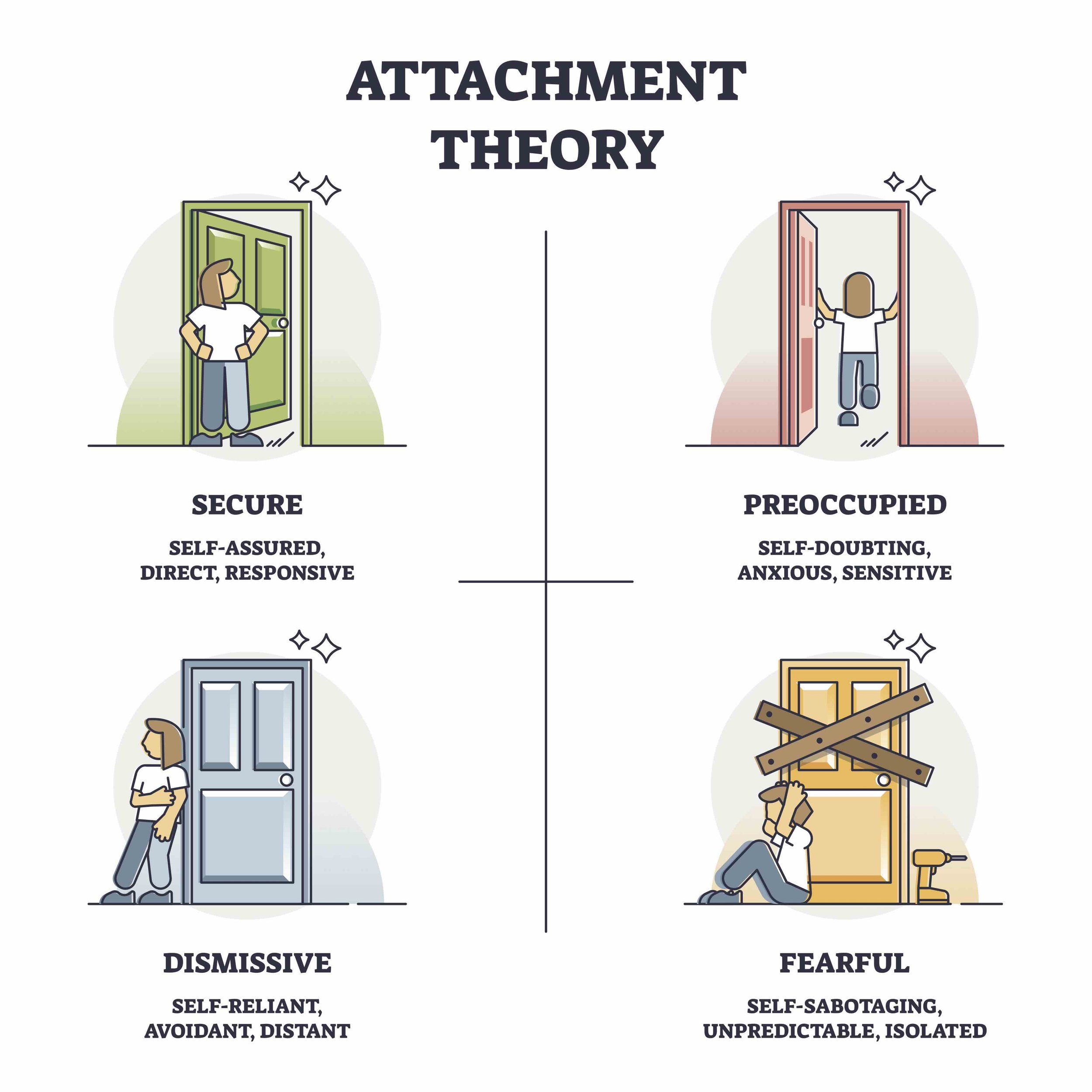Self-Esteem & Attachment Style
Have you ever wondered why you struggle with self esteem, especially in relationships? It might have something to do with your attachment style.
The 4 attachment styles & their self-esteem (overview)
There are 4 attachment styles: Secure, Anxious (Preoccupied), Avoidant (Dismissive), and Disorganized (Fearful Avoidant).
4 attachment styles
In the Secure attachment style, people tend to have a strong sense of self-worth and confidence. They are comfortable with giving and receiving support. They trust themselves and are skilled at expressing their needs and helping others meet their needs.
In the Anxious (Pre-occupied) attachment style, people seek out relationships with a lot of closeness, expressions of love, and intimacy. They tend to focus on whether the relationship is stable or not, and sometimes this focus can lead to relational instability. They get attachment discomfort when their partner moves away from them relationally. Their self-esteem fluctuates, so they may be more dependent on their partners for validation.
In the Avoidant (Dismissive) attachment style, people are more comfortable with independence and self-reliance in their relationships. In contrast to the anxious style, their attachment discomfort comes up when their partner moves toward them relationally. Their self-esteem can appear to be high but is masking insecurities.
And finally, in the Disorganized (Fearful Avoidant) attachment style, people want connection but fear being vulnerable, so this can lead to relational unpredictability. They tend to have low self-esteem.
Please understand that people typically have one *primary* style, and more than one attachment style overall.
We’ll go into these in a little more detail later on. It’s important to understand that we’re all unique, and have other factors that play into self-esteem besides attachment, such as personal success, culture, genetics, body image, physical health, and education.
But first, let’s talk about how the attachment styles develop.
How the attachment styles develop
Attachment styles are adaptations to our environment when we’re young. They can continue to change throughout life based on our relationships, life events, and the conscious work we do on them.
Secure attachment develops when a caregiver is consistently responsive to what the child needs, giving them comfort, attention, and safety. This helps the child develop trust and a positive view of themselves, and of other people.
Anxious attachment develops when a caregiver is inconsistently responsive. Sometimes the child gets their needs met right away, sometimes the caregiver is preoccupied themselves or busy. This inconsistency creates anxiety for the child, so they become preoccupied with seeking reassurance and validation.
Avoidant attachment develops when caregivers are unavailable, dismissive, or neglectful. The child learns to suppress their need for closeness and connection, and they become self-reliant and distant in relationships.
Disorganized attachment develops when caregivers are highly inconsistent or unpredictable, so the child is confused or afraid. The caregiver might be a source of stress instead of comfort, and this is very confusing to the attachment system. This style is a mix of anxious and avoidant behaviors.
The 4 attachment styles & their self-esteem (detail)
So what’s the result of these different scenarios in childhood on adult self-esteem and relationships?
Let’s go back to how attachment style plays out in each of these 4 styles’ relationships.
The secure style & self-esteem
In the secure style, because the person is accustomed to getting their needs met with another person, they’re given a really good model on how to help other people meet needs.
This makes them team players. They’re thinking of relationships as a 2-person system rather than a 1-person system, like a team where they are rooting for their partner as well as themselves.
They also internalize the idea that they are deserving of love and care, so they have a strong sense of self-worth. While self-esteem can be derived from other people, our sense of self-worth comes from ourselves. Secure people have essentially taken that love from a parent and internalized it.
And they have a positive view of others as well. They’re able to engage in healthy interdependence, where people are depending on each other to get needs met. They don’t solely rely on someone else, and they don’t expect themselves to be 100% self-reliant. Their worldview is essentially that we all help each other, and it’s a beautiful network, and that’s okay.
And guess what — because they have a positive self-view, they’re not overly reliant on their partner to feel good about themselves, which means they can communicate their needs openly while also being attuned to their partner’s needs. Because they’re not worried that their partner is going to abandon them if they share a need, and they’re not worried that their partner is going to suffocate them if their partner shares a need. So this leads to a lot of mutual trust and relational stability and security.
The anxious style and self-esteem
Now in the anxious style, remember that people didn’t have the consistent care that they needed to trust the relationship was okay. When the caregiver was sometimes available and sometimes not, the child learned their needs might not always be met. This created a deep-seated anxiety and reliance on external validation to feel worthy and loved. And that’s why in the anxious attachment style, people can have a self-esteem that’s highly dependent on approval and attention from other people.
In relationships, this shows up as a preoccupation with their partner’s feeling and behaviors. They might focus on looking for signs of rejection or abandonment, which makes them ask for reassurance or become more dependent or overly attentive. Their fear of not being “enough” can make them prioritize their partners needs over their own, often to the point where they neglect their own needs. This can make for an imbalanced dynamic, where the anxious person in the relationship is struggling to express their needs, because they’re afraid of rejection or abandonment, and this causes them to feel resentful or dissatisfied. Their self-worth is based on the state of the relationship, so they’re vulnerable to cycles of anxiety and insecurity.
How the anxious style can boost their self-esteem
Let’s talk about 3 ways you can boost your self-esteem if you have anxious attachment.
First, lean into self-compassion.
Practice speaking kindly to yourself, like someone would talk to a friend who was going through a hard time. If you catch yourself being mean to yourself, stop and say something encouraging and empathetic. You can practice doing these on your own, if you’re used to turning to a partner to tell you something encouraging. I also want to clarify that there’s nothing wrong with asking for some validation from others. If you didn’t get it growing up, it can feel great. You just don’t want to be completely reliant on other people for your self-esteem.
Second, challenge your negative beliefs. If you have a belief that you’re unworthy of love, that can really hurt your self-esteem. So find an affirmation that is more realistic and positive to repeat. Working with the subconscious can be a valuable way of challenging negative beliefs and developing beliefs that help you meet your goals. I have found hypnosis to be a powerful way of shifting beliefs to be more positive and affirming.
Third, set boundaries.
This might be recognizing what your needs are in relationship and learning how to express them. Setting boundaries helps you to assert your own worth and prevents over-depending on others for your self-esteem. I’ve worked with many people who wanted to get more clarity around their needs and how to communicate them. One client for example told me that the work helped them to increase their self-esteem and speak up for their needs in a way that didn’t involve blaming their partner.
I have a course for Boundaries for Anxious Attachment style that you can find here.
So those are a few ideas for the anxious attachment style to boost self-esteem.
Next let’s talk about the avoidant style and self-esteem.
So remember, in the avoidant style, someone didn’t get the attention, care, or time that a child really ought to get. A caregiver might have been emotionally unavailable or dismissive. That means they ended up relying heavily on themselves as well as suppressing some of their needs like care and attention. Think about it, it’s a smart adaptation for a kid who is trying to navigate the world.
That’s why folks with the avoidant style might base their self-esteem on their independence or ability to handle things on their own. Vulnerability might feel too much like a way to get rejected or hurt.
In relationships, this outwardly high self-esteem might manifest as emotional distance or autonomy. They might even be proud of their ability not to need other people, which can make it hard to form deep, intimate relationships. The self-reliance can be a strength, but it creates challenges in relationships because they feel uncomfortable being vulnerable or depending on others and giving and receiving mutual support. And these things build self-esteem, when we are vulnerable with someone and they recognize us and give us positive attention for who we are. Over time, avoiding emotional intimacy can lead to isolation and lower self-worth, so it’s worth looking into how to get more comfortable with vulnerability, and perhaps building positive experiences with being vulnerable.
How the avoidant style can boost their self-esteem
Let’s talk about 3 ways you can boost your self-esteem if you have avoidant attachment.
First, lean into self-compassion. Just like with the anxious style, this is so important, because this self-compassion counteracts shame and makes people feel more positive about their experience.
Give yourself some self-compassion when you struggle with vulnerability or closeness. This helps manage stress and increases your positive self-view, so you can build that self-esteem from within.
Second, acknowledge and embrace vulnerability. I know that could sound scary, but first I want to say that vulnerability is a strength, not a weakness. You can start small, with people you know who you don’t think will reject you, and just open up in small ways. Maybe ask them for their opinion or a small favor. This helps because over time you can notice that emotional openness doesn’t diminish your independence. Instead it creates deeper connections where you are being valued for more than simply your self-reliance. You might be thinking — that’s all well and good for friendships, but in a long-term relationship, wouldn’t I lose independence? To that, I’d say you’re not losing independence so much as integrating it into a supportive partnership. And you can create a relationship where people respect each other’s autonomy while also being there for each other. When partners are interdependent, they keep their autonomy but also support each other’s personal growth and well-being.
This brings me to a third way that the avoidant style can boost self-esteem — to challenge negative beliefs about dependency.
We all need the support of other people, it’s part of what makes us human. It’s a normal and healthy part of life.
Let’s move on now to…
Disorganized attachment and self-esteem
Remember that in the disorganized attachment style, people have a low and unstable self-esteem, and received unpredictable and inattentive care during childhood. The caregiver might have been a source of confusion or fear. They *may* also have been a source of comfort. But either way it’s confusing because we expect an attachment figure out to be comforting and safe.
This inconsistency gives people with disorganized style a deep sense of unworthiness and distrust, because they learn their environment is unpredictable and they’re not getting their needs met consistently.
And there’s the problem in relationships — this lack of stable self-worth can mean chaotic and contradictory behaviors. They both seek closeness and are afraid of it, because of the history of having that attachment figure also be scary or chaotic.
Partners can find this confusing, and this adds to the person’s expectation of rejection or betrayal. This can become a self-fulfilling prophecy if they sabotage relationships out of fear. For example, they might preemptively sabotage relationships to avoid the pain they anticipate. So they find it hard to trust themselves or other people.
Their low self-esteem contributes to a lack of trust. They might question their partner’s commitment or their own worthiness of being loved.
How the disorganized style can boost their self-esteem
First, it can be especially helpful to get support working through and letting go of emotions from negative life experiences. Somatic-based modalities can be helpful because of the way that trauma is stored in the body.
Second, that self-compassion is once again super helpful for the disorganized style, because self-esteem and self-critical thoughts typically go hand in hand. Self-compassion meditation or writing compassionate letters to yourself can be one way to learn or remember how to treat yourself with kindness. As you talk more kindly to yourself, you will start to see yourself in a more positive light.
Third, practicing emotional regulation such as mindfulness, self-hypnosis, breathing exercises, or grounding techniques can help you to feel more calm and grounded.
Having better emotional regulation leads to more relational stability, which boosts your self-esteem because it reduces the chaos and unpredictability that can go along with this style.
So we’ve talked about some different ways that attachment style and self-esteem are connected, and ways to boost self-esteem for the different styles.
Enjoyed this article? Get attachment tips like this direct to your inbox!
Want to work on everyday habits to build secure relationships?
Download the 10 Ways to Build Secure Attachment and a Fulfilling Relationship.





